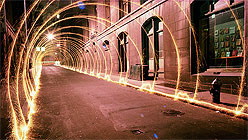Motion Graphics: In and Beyond the Street is a group exhibition of six artists whose work is grounded in direct action and inspired by graffiti and street art. Curated by Kevin B. Chen, Intersection’s Program Director for Visual Arts, Literary and Jazz, the exhibition includes performance, painting, sculpture and photography that engage social and political action as both a subject and a medium. Visitors first encounter a video by Ricardo Richey, known widely as graffiti artist Apex. It features the artist repeatedly spray-painting various signature San Francisco tags, or rather “hand styles.” This reference to “traditional graffiti,” if such a term exists, foregrounds the ways in which the exhibition considers the evolving nature of more recent ephemeral interventions by artists in the public sphere.
A long view of graffiti is intertwined with an examination of the social conditions of the last several decades. Some work in the ’80s expressed concerns around the Cold War and AIDS, for example, while some in the early ’00s addressed 9/11 and the ensuing war in Iraq. The Arab Spring and rise of social media are reflected more recently. Concerns around gentrification and homelessness, among other issues related to wealth disparity, are ever present. In this same vein, each of the works in this exhibition implicates a number of pressing contemporary issues including racially driven gun violence and immigration.

Photo: Ricardo Richey
It is interesting to note that while graffiti tags often signify self-assertion —I claim this space— some work in Motion Graphics is achieved by tactically erasing visual information from the public domain. Evan Bissell’s Oakland Police Shooting/Arkansas Anti-Education Mob, 2012, acrylic on Plexiglas, features details from two widely distributed media images. One depicts former BART police officer Johannes Mehserle, photographed while shooting unarmed and subdued civilian Oscar Grant. In the second painting, Bissell references a famous image from the first day of school integration in Arkansas in 1957. In each life-sized painting, disembodied hands clutch phantom weapons. Chillingly this work asks the same questions being asked in light of the shooting rampage in an Aurora, Colorado movie theatre last week: What is to be done about gun violence in this country? Processing the image, the viewer is lead through the artist’s internal dialogue: Who do I blame? Can I see myself in this history? But surely the viewer is implicated: the highly reflective surface of Bissell’s materials, in fact, implicates everyone.

Ana Teresa Fernandez, Borrando la Frontera, 2011.
Ana Teresa Fernandez’s Borrando la Frontera: Erasing the Border, 2011, is video documentation from a one-day performance by the artist at the oceanic fence that divides Mexico and California in Playas de Tijuana and San Diego. The video shows the artist “erasing” the fence with white spray-paint, climbing up and down a towering ladder in her preferred work clothes, a signature black cocktail dress and stilettos. As the film progresses, the fence astonishingly does begin to look like it has been removed against the backdrop of sand, sun and water. The painting is steady and uninterrupted until the artist is confronted by Mexican police, but the next scene shows her back at work after having somehow talked her way out of blatant vandalism. The artist presents such a disarming figure, I half expected to see the police helping her in the next frame. Since there is no dialogue, one can only assume that the authorities were completely befuddled by this woman dressed for cocktails while illegally painting federal property on the beach. As many artists can attest, unsanctioned performance art in broad daylight is often forgiven on the basis of sheer audacity.


